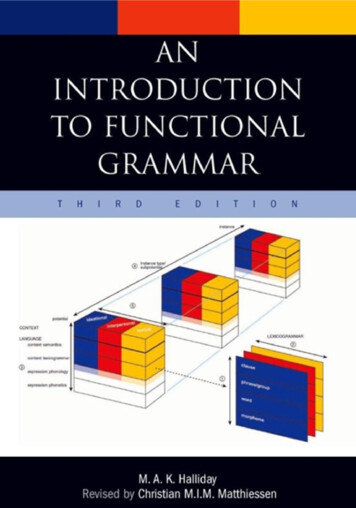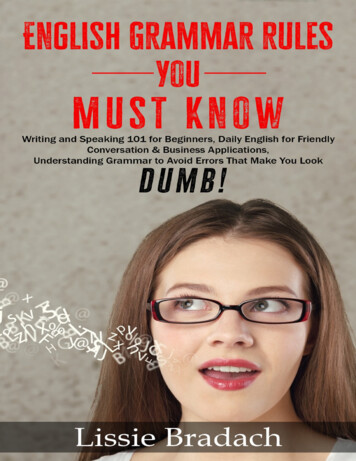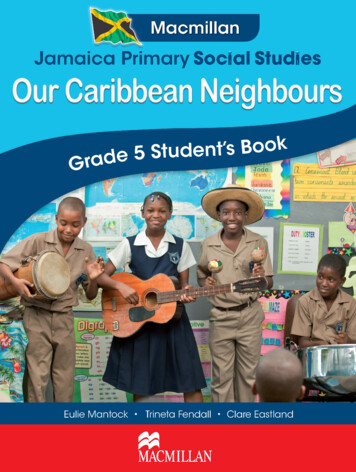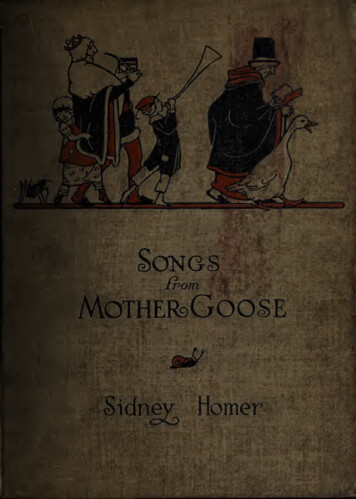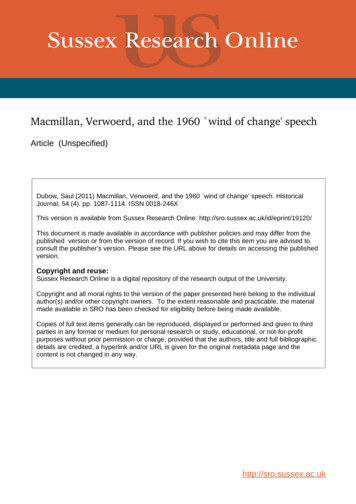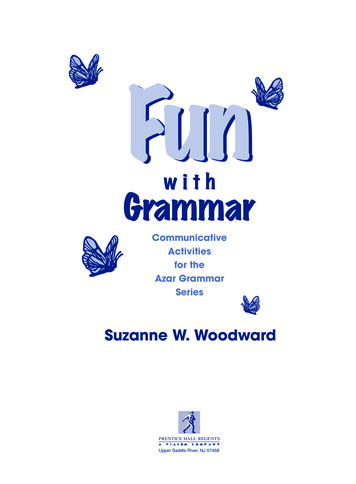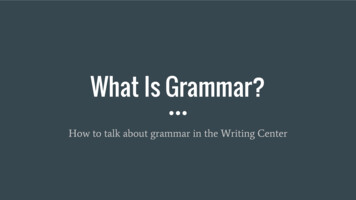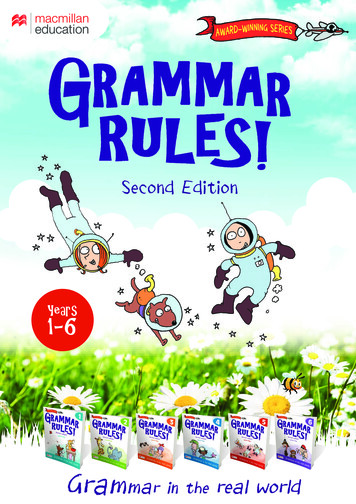
Transcription
AWARD-WINNING SERIESSecond EditionYears1- 6Grammar in the real world
SecondEditionGrammarin the real worldThis award-winning series has been revised to meet thelatest requirements of the Australian Curriculum: English.Grammar Rules! provides a context-based approach,demonstrating how grammar works at the word, sentenceand text levels to communicate and make meaning. Studentsunderstand how to use grammar when constructing their owntexts and responding to the texts of others – in the real world!Grammar Rules! is a sequential, whole-school program thatis systematic and fun! Each unit covers a range of informative,imaginative and persuasive texts and is based on a model textthat establishes the context for the grammar focus.Starting with a model text, students finish the unit writing theirown text, putting new grammatical knowledge into practice.States the main grammarfocus for the unitSequenced activitiesfocus on a specific aspectof grammarRule! Introducesstudents to a newconceptStudent Workbook2Reflection box in studentbooks 1–4 allows students toassess their progressTip! Reminds orgives a special hint
Type of text description highlightsthe purpose of the sample textText model illustrates thegrammar focus in context ofa specific type of textStudents put theirgrammatical knowledgeinto practice in theirown writingStudent WorkbookFooter lists the grammarfocus covered in the unitThis second edition of GRAMMAR Rules! includes: revisions by the same well-regarded first edition authors all the much loved practical features including the quirky and fun illustrations updated weekly unit activities to meet curriculum requirements scope and sequence charts that reflect Australian Curriculum descriptions a new reflection box in student books 1– 4 that allows students to assesstheir progress a disc with the Teacher Resource Book, giving access to teaching notes,rules and tips, reproducibles and bonus wall 420236606978142023661397814202366203
Teacher Resource BooksThe Teacher Resource books are packed with valuable backgroundinformation that explains what grammar is, provides strategies and activitiesfor teaching grammar, assessment tools for teacher and student feedback andanswers for every unit.9781420236637The Teacher Resource books now include a disc that: facilitates ease and convenience as teachers have digital access to teachingnotes and can print reproducibles rather than photocopying9781420236644 contains teaching notes, text models, glossary and answers to activities contains a list of grammar rules and tips as well as bonusGrammar Rules! wall charts.Each weekly unit providesa grammar focus andspecific type of textEach unit correspondsto the student bookand unit numberUnits cover a range ofinformative, imaginativeand persuasive textsEach unit builds uponknowledge gained inprevious unitsTeacher Resource BookPractical activities aresuggested for each unit4
Scope and Sequence chartsA scope and sequence chart is available at each year level in boththe Student books and the Teacher Resource books.ScopeandSequenceClause to whole text levelThis scope and sequence chart is based on the requirements of the Australian Curriculum.Clause to whole text levelUnitUnit name/Type of ical chains,connectives1Things in the GardenInformation report/Diagramcommonnouns2A FishInformation report/Diagramcommonnouns3Shopping ListInformation report/Shopping listcommonnounsproper nouns4A Family TreeInformation report/DiagramOur Weather ChartInformation report/Weather chartproper nouns;commonnouns;describingadjectives5Verbs and verbgroupsJobs on the FarmInformation report/Map8At the PlaygroundRecount9Class RulesInformation report/Rules10The Fire BrigadeRecount11Goodbye ElvisRecountcommands1920222326doing verbs27doing verbs28nounsadjectives;proper nouns12adverbs andprepositions totell whensaying verbs2913A Moreton Bay Fig ns ectives32Our Favourite PetsInformation report/Graphsingular andplural nounsdoing verbs1516My oing verbs17Fish Tank DioramaProcedure/Instructionscommandsnounsdoing verbsNouns andnoun groupsVerbs andverb groupsnounsdoing verbsAdverbs andprepositional phrases Provides grammarfocus at clause towhole text levelquestions;questionwords: who,what, where,when, how,why; opinionThe Lonely DragonNarrativeconjunctions(connectives):and, but, so,becauseHow We Get Our MilkExplanation/Flowdiagramsentences Provides grammarfocus at word andword group levelproper nounsfact andopinion;rhymeREVISIONWednesday and RubyNarrativeonomatopoeiaBuy fella’s JobsProcedure/InstructionsMagic erbs andprepositional phrasesto tell whenadjectives;proper nounsantonymscommandslogical order30adverbs to tellwhenREVISIONMood andmodality,languageandvocabularyrhymeproper nounsfor place names;common nouns24nounsnounsSleepy CatDescription/PoemDear Aunty Selma andUncle KenanResponse/LetterWhen I Grow UpDiscussionCohesion:theme,pronouns,lexical lamationsSentencesandclausesUnit name/Type of textAdverbs andprepositionalphrasesREVISION67UnitWord and word group levelMood andNouns andmodality,noun groupslanguage andvocabulary Each unit features aspecific type of textWord and word group levelthinking andfeeling verbsnounsdoing verbsadverbs to tell hownumberadjectivesREVISIONLife CycleExplanation/CyclediagramHow to Get HomeProcedure/Directions33Book ReviewResponse/Book review34KoalasInformation reportcompoundwordsnounsdoing verbsdoing verbsquotedconjunctions questions;speech;(connectives): opinionspeech marks and, but, l phrasesto tell ssayingverbs; doingverbsREVISION35REVISION184536576 Grammar Rules 2e SB Bk1.indd 46/05/16 7:49 AM36576 Grammar Rules 2e SB Bk1.indd 56/05/16 7:49 AMI've tried thesetypes oftexts andtext forms . . .(imaginative)NarrativeExplan ationStoryPlay scriptComicLetterOther(imaginativeExposor informative)ition (persuasive)(argues oneside of anissue)DebateBiographySpeechAutobiog raphyNewspaperarticleLetter to editorEditorialOtherTV advertisementMagazine advertisementRadio advertisementDescri ption(imaginativePoemor informative)LeafletOtherStoryPlay scriptBiographyDigitalDiscussion (persuasive) (presentmore thansone side ofan issue)OtherInform ationreportScientific reportConversationTV interview(informative)Talk-back radioDialogue ina storyPanel discussionWebsiteMagazine articleDocumentaryOtherOtherProced ureCookbook(informative)Magazine articleReference bookBalladOtherRecou ntRespo nse(persuasive)Film or bookreviewDiary or journal(informative)PoemInstructionmanualGame rulesOtherOtherivGrammar Rules!Student Book6 (ISBN 9781420236620) Tanya Gibb/Macmillan36620 GrammarRules 2e SB Bk6.indd 4Education AustraliaCompound10/05/16 12:28PMand complexsentences; clauses;verb groups;Grammar Rules!relativeStudent Book6 (ISBN 9781420236620 pronouns; conjunctions) Tanya Gibb/MacmillanPosters(connectives);Education Australiaadjectival phrases5
Try a kworfotinuin your !omclassroYear1StudentBook 1Grammar Focus: Doing verbsType of Text: Informative – RecountUnit 8Tell students words that represent an action arecalled doing verbs or action verbs. Brainstorm aclass list of doing verbs for actions in the school.Give the list a title such as What we do at school,and list things like read, draw, play, listen, run,pretend, act, count, sing and so on. (It does notmatter, at this stage, if students list saying verbsor thinking and feeling verbs with the doingverbs. They will learn the distinctions as theyprogress through the units.)Unit 8Grammar focus: Doing verbsType of text: Informative – RecountQuestion 5 asks students to write the doingverbs a hand can do. Have students trace aroundtheir hands or provide them with photocopiedhand outlines. Tell them to decorate their paperwith drawings and to write on the hand all thethings their hands can do using doing verbs.Display their hands. Teaching notes elaborate on words that representan action. Activities focus on exploration of doing verbs andintegrates a unit of work on the senses.Create a touchy-feely bag with items inside studentsneed to feel and give noun labels (sandpaper,modelling clay, cotton wool, comb, plastic dinosaur,teaspoon, laundry peg, bulldog clip . . .).Blindfold students in turns and have themtouch textured objects like cold cooked soggyspaghetti, kiwi fruit, rambutan, coconut shell.Have students use describing words (adjectives)to describe the way things feel: smooth, spiky,prickly, slimy, soggy, cold. Create a list of wordsthat describe. (Be aware of any allergies studentshave, and make sure they don’t taste any of thefood items.)Integrate this unit with a unit of work on thesenses. Use noun and verb labels: eyes can see;ears can hear; tongues can taste; brains can think;noses can smell; skin can touch.StudentBook 1Grammar Focus: Commands, exclamationsExtract1–2, p46Type offromText:TeacherInformativeResource– InformationBookreport/Rules8Unit8DoingverbsThis recountis informative.It tells abouta trip to theplayground.Brainstorm a list of class rules for your classroom.Where possible try to write students’ suggestionsin a positive way. For example, ‘Don’t run in the3 Circle the doing verbs a dog can do.classroom’ could be written ‘Walk indoors’.Compare your list of class rules with the ClasseatwriteRules in the student book.At the PlaygroundUnit 9Tell students about commands that are alsoexclamations because they are said in surprise oranger. Ask what exclamation they might make if4 Circle the doing verbs for cooking.they see someone carrying scissors and about tostep on something slippery: ‘Stop! Be careful!’Point out the doing verbs at the start of mostchasecommands. Even commands that start with aDiscuss flyrules for other situations, such as roadfrychopswimnegative such as ‘Do not walk’ still start with arules, beach safety, swimming pool safety, use ouseholdrunreadmixcleaning products. Ask students why rules areTalk aboutgrillthe way a person’s voiceand facialsleepneeded. Talk about the purpose of rules: to keepexpression can makebakea command seem reallypeopleswimsafe. Talk about the consequencesofnotsleepbossy. Have students work in pairs. Have onesneezefollowing rules. For example, some students likescratchmember of eachpair be a parent and the otherscratchto balance theirchairs on twobeglegs. A class rulea child. Tell parents to be really bossy andmight be ‘Keep all four chair legs on the floor’.command‘Tidyroom’. Swap5 Choose doing verbs from the box that a handcan do.theirWritechild:themon yourthe hand.A consequence of disobeying the rule mightroles. Have parents give commands in a lessbe to tip over and bang your head on the floor.bossy manner. Discuss the differences made byAnother classrule mightbe ‘Never walk arounddrawpaintvoice, facial expression and body language.with scissors in your hand’. Discuss the potentialreadwriteconsequences of disobeying this rule.Yesterday Mira took me to theplayground. Mira is my neighbour.First we played on the seesaw. ThenMira watched me on the slippery dip.After that she pushed me on the swing.She pushed me really high.We threw the ball to Mira’s dog for awhile before we went home.I had great fun at the playground.46scratch seesit fly chopsneezeI Read At the Playground. Underline the nouns for things in the playground.Rule!6 Write a sentence to tell what each animal is doing.Doing verbs tell the actions.eat push play jump2 Choose the correct doing verb from the box. Write it on the line.chasedMiraThe dogIMiraWe2036576 Grammar Rules 2e SB Bk1.indd 206threwpushedclimbedwentthe ball.the ball.Try ityourself!the slippery dip ladder.the swing.Write a recount about somethingyou have done. Use doing verbs.ReflectionI can do this.I am not sure.I need help.to the playground.Doing verbs;Doing nounsverbs; nounsGrammarGrammarRules! StudentRules!BookStudent1 (ISBNBook 9781420236576)1 (ISBN 9781420236576) Tanya Gibb/Macmillan Tanya Gibb/MacmillanEducationEducationAustralia AustraliaGrammarGrammarRules! StudentRules!BookStudent1 (ISBNBook 9781420236576)1 (ISBN 9781420236576) Tanya Gibb/Macmillan Tanya Gibb/MacmillanEducationEducationAustralia Australia6/05/16 7:47 AM36576 Grammar Rules 2e SB Bk1.indd 21216/05/16 7:47 AMStudent Workbook 1, pp20–21Grammar Rules! Student Book 1 (ISBN 9781420236576) Tanya Gibb/Macmillan Education Australia
Year2Grammar Focus: Questions and statementsType of Text: Informative – Interview/Questions and answersWildlife Carer is an interview. It begins with anorientation and then includes questions andanswers.Remind students that sentences start withcapital letters.Unit 20Tell students that questions are sentences thatask something. Questions end with questionmarks rather than full stops.Grammar focus: Questions and statementsType of text: Informative – Interview/Questionsand answersAnswers are usually statements. They aresentences that give information and/or opinions.Answers end in full stops.Write the words who, what, where, when, how,why on a chart for student reference. Tellstudents that these are useful question starterwords. Play Hot Seat and have students beinterviewed by other class members (see page17 for instructions on Hot Seat). Students canpretend to be story characters, someone theyknow, a television character or someoneworking in a particular occupation. Teaching notes elaborate on questions, statements,facts and opinions. Activities focus on question starter words and interviewquestions, and explore fact and opinion statements.If appropriate, investigate the work of organisationsin your area that assist sick or orphaned nativeanimals. It might be possible for a volunteer tovisit your school and talk about the work of theorganisation. Prepare interview questions with theclass prior to any visit by a guest speaker.Talk to students about the difference betweenfacts and opinions. Create a chart that has twocolumns labelled Fact and Opinion. Have studentswrite a fact and an opinion onto strips of paperand attach the paper to the chart columns. Allowthem to use the factual books on display in theclassroom to find facts.Grammar Focus: Prepositions8Unit20QuestionsandstatementsThis interview isinformative. Itincludes questionsand answers.Wildlife CarerA wildlife carer visited our school. These are somequestions we asked, and her answers.What kinds of animals do you look after?I look after any sick, injured or orphaned nativeanimals. I often care for native birds and possums.I had training. Plus there is a buddy system. Whenyou first become an animal carer you are matched tosomeone with more experience than you. My buddyhelped me a lot.A question asks for information or an opinion. It ends in aquestion mark.What is the time?Have you fed the cat?StudentBook 2Unit 21Tell students that groups of words that tell wherethings happen in a story are called phrases thattell where (or where phrases): on the branch,under the tree, in the barn. Ask students to orallysuggest other ‘phrases that tell where’ to suitthe picture of the farm in the student book. Forexample in the grass, under the water, along thepath. Ask students to listen out for ‘phrases thattell where’ in stories you read to them.Remind students about story maps they mayhave explored in narratives that they have read.If students have trouble with question 3, they canrefer to the picture on page 47 to help them decideFocus students’Whatattention on words that tellwhether the statements are facts or opinions.where eachhappenedanimal is ontothe farm. Point out thelittle words, called prepositions, that show theyou?relationship between a noun or pronoun andanother word. In Where’s My Mum? most ofthe prepositionstell where:under,whetherin, on, beside,to showeach statement gives a fact or an opinion.6 Tick a columnbehind, near.How do you know what to do for the animals?Rule!Unit 20Have students use the question starter wordsto ask questions of the person in the Hot Seat.ExtractType of fromText: TeacherImaginative Resource– Narrative Book 1–2, p68Read the narrative Where’s My Mum? withstudents. Organise students to perform thenarrative as a play. Choose students to bethe ducklingandtheeachof the otheranimals inpossum’sanswer.4 Writethe narrative. Then have the duckling ask thequestion of eachanimal in sequence: “Cow, haveWhatyou seen my mother? Horse, have you seen myhappenedtoeach animal respondmother?” andso on. Haveto the question you?appropriately. The students cancreate their own dialogue. Involve all the studentsin the class as extra, different animals or they cananswer5in Writeunison,theas pelican’sgroups ofanswer.each particularanimal in the narrative.StudentBook 2FactOpinionDogs have four legs.68I Read Wildlife Carer. Underline the two questions.Lucy is scared of dogs.Wombats are mammals.2 Write three questions you would ask a wildlife carer.I love wombats.7 Write a fact about the spider picture.Rule!A statement can be a fact. Polar bears live at the North Pole.A statement can give an opinion. Polar bear cubs are cute.Statements end in a full stop.3 Answer the question with a statement that gives your opinion.Would you like to be a wildlife carer? Why or why not?Write an opinion about the spider picture.Try ityourself!Work with a partner. Interview a student orI can do this.about their favourite animal. Write the questionsI am not sure.and their answers.4436583 Grammar Rules 2e SB Bk2.indd 44Questions;Questions;statements;statements;fact andfactopinionand opinionGrammarGrammarRules! StudentRules! BookStudent2 (ISBNBook 29781420236583)(ISBN 9781420236583) Tanya Gibb/MacmillanTanya Student Workbook 2, pp44–45GrammarGrammarRules! StudentRules! BookStudent2 (ISBNBook 29781420236583)(ISBN 9781420236583) Tanya Gibb/MacmillanTanya 10/05/16 11:43 AMGrammar Rules! Student Book 2 (ISBN 9781420236583) Tanya Gibb/Macmillan Education Australia36583 Grammar Rules 2e SB Bk2.indd 45Reflectionteacher at your school. Ask them three questionsI need help.4510/05/16 11:43 AM7
Year3StudentBook 3Grammar Focus: Evaluative words, quoted speechType of Text: Persuasive – Discussion/ConversationOrganise a Readers’ Theatre presentation ofTrampolines (see page 18 for instructions).Allocate one student to say Henry’s linesand another student to say Dad’s lines. Haveanother student or the rest of the class read thenarrator’s lines. These will be all the text that isnot actually spoken by the two characters. Talkto students about the speech marks and theway they function to mark what characters areactually saying.Unit 13Grammar focus: Evaluative words, quoted speechType of text: Persuasive – Discussion/ConversationPoint out the quoted speech in Big Booksavailable in your school. Point out the sayingverbs that tell how each character is saying theirspeech. Brainstorm a word bank of saying verbsto display in your classroom. Students can referto this list when they are writing their own texts. Teaching notes elaborate on quoted speech,speech marks, evaluative words and apostrophesfor contractions.Unit 13Suggest that Henry and Dad discuss otherinventions about which they might have differentopinions such as televisions, hand-held electronicgames, war toys, skateboards and so on. Makesure that students recognise that opinionsinclude evaluative words. Evaluative words givea valuation or judgement about something.Point out that people are entitled to evaluatethings differently and have different opinionsand that it is important to listen politely tothe opinions of others and then make up yourown mind. Give examples that are relevant toyour students. Tell students that it is also OK tochange your own opinion after listening to theopinions of others.Tell students that in discussions people presenttheir opinion or points of view. Ask students tocompare Henry’s opinion about trampolines withDad’s opinion. Ask for volunteers to continue thediscussion between Henry and Dad. Activities focus on a readers’ theatre presentation ofthe model text and the function of speech marks, andexplores persuasive discussions.StudentBook 3Grammar Focus: Point of view, emotive wordsExtractType offromText:TeacherImaginativeResource– Narrative Book 3–6, p488UnitI3Evaluativewords, quotedspeechThis text is adiscussion. Each personmakes persuasivestatements that tell theirpoint of view.Choose students to present The Thing InsideTell students that the sample text The ThingInside is a narrative in which the characters try to as a Readers’ Theatre (see instructions onpage 18). Point out the question marks andchange each other’s minds about an issue. Theythe exclamation marks as well as the speechtry to sound very convincing so that they win6 Write the saying verbs used in Trampolines formarks. Point out the saying verbs (argued, fumed,the argument. Explain how body language, tonehowspeaksexplained, announced, asked) that will tell theof voiceandDadgesturecan be used in arguments toreaders how to say their speech.make howthemHenryseem evenmore persuasive. Talk tospeaksstudents about the words used by Deni and Amy,Have students use substitute saying verbs in Theas well as the way the words are spoken usingThing Inside and repeat the Readers’ Theatre activity.voice and gesture. Words and phrases such asFor example, instead of argued Amy in the first7 Circle the saying verbs in the box.Don’t be a chicken and It will be fun are emotive.paragraph, students could substitute whined Amy.Emotive words are used in arguments to soundDiscusslaughedthe differencesmade bypeepedthe saying verbs.whisperedyelledswamwhinedaskedmore persuasive.Have students work in groups toPoint out the name-calling by Deni and askcreate frozen sculptures for emotiveEvaluativewordstell us people’s opinions and judgements about something.students whetherthis is a fairor appropriatewords in The Thing Inside, such asdeliciousfoodbraveexplorerthing todoinanargument.DiscusswhypeopleRule!trespassing, fumed, treasure.call each other names in an argument.Trampolines“Dad,” asked Henry, “Do you think thetrampoline was a good invention?”“I’d say that jumping on a trampoline is goodexercise, as much fun as jumping on the bedbut probably safer than jumping on the bed,”Dad suggested. “What do you think?”“I really like jumping on the bed but I’m notallowed,” reminded Henry.“You certainly are not allowed to jump on thebed. Jumping on the bed is dangerous with8 Write down some evaluative words in Trampolines that tell you Dad’s opinion.all the furniture nearby, so it’s just as wellabout trampolinesthe trampoline was invented,” lectured Dad.Rule!IUnit 14about jumping on the bedQuoted speech is the actual speech someone says.It is written inside speech marks.“What do you think?” asked Dad.48Rule!Read Trampolines. Highlight the words that Dad says. Use a differentcolour to highlight the words that Henry says.2 Work with a partner. One of you say Dad’s speech. One of you say Henry’s speech. Then addApostrophes can be used in shortened forms of words.They show that a letter or letters have been left out.The shortened forms are called contractions.she isshe’sI haveI’ve9 Find three contractions in Trampolines.some extra questions and statements to their discussion.3 Write what Henry would say next as quoted speech.IO Write contractions for the words.4 Write what Dad would say next as quoted speech.5 Add speech marks to show which words are being said. The speech marks go outside thecan notwould haveshould haveI willyou willTry ityourself!punctuation.I want a turn! shouted Billy.is notThat’s so funny, giggled Marie.Dad whispered, Santa Claus might bring a trampoline.Can I have a turn? begged Susan.3036590 Grammar Rules 2e SB Bk3.indd 308Discuss your favourite game or sport with a partner. Recordpart of the discussion. Use speech marks to show whatwas said. Use saying verbs to tell how each person spoke.QuotedQuotedspeech;speech;speechspeechmarks; marks;saying sayingverbs; verbs;evaluativeevaluativewords; words;apostrophesapostrophesfor contractionsfor contractionsGrammarGrammarRules! StudentRules! BookStudent3 (ISBNBook 39781420236590)(ISBN 9781420236590) Tanya Gibb/MacmillanTanya GrammarGrammarRules! StudentRules! BookStudent3 (ISBNBook 39781420236590)(ISBN 9781420236590) Tanya Gibb/MacmillanTanya 10/05/16 11:04 AM36590 Grammar Rules 2e SB Bk3.indd 31ReflectionI can do this.I am not sure.I need help.31Student Workbook 3, pp30–3110/05/16 11:04 AMGrammar Rules! Student Book 3 (ISBN 9781420236590) Tanya Gibb/Macmillan Education Australia
Year4StudentBook 4Grammar Focus: Commands, adverbsType of Text: Informative – Procedure/InstructionsUnit 15Grammar focus: Commands, adverbsType of text: Informative – Procedure/InstructionsPoint out to students that How to Catch a Fishis a different type of procedure text from therecipe in Unit 14. This text is a set of instructions.Instructions tell how to do something.Instructions begin with a goal or statement ofaim, the same as a recipe. Then the steps toachieve the goal are listed in logical order.Instructions do not usually have exclamationmarks unless it is for a command such as‘Beware!’Make sure students notice the doing verbs at thebeginning of each line. The doing verbs make eachline a command. Commands tell you what to do.Adverbs that tell how end in –ly. Examples ofadverbs that tell how include swiftly, slowly, loudly.Instructions sometimes make use of adverbs thattell how to ensure people follow instructionscarefully.Tell students that sometimes commands endin an exclamation mark. Exclamation marksare used when something is said loudly or inanger or surprise. Commands as exclamationscan be found on signs and notices as well as innarratives. Teaching notes elaborate on commands, verbsand adverbs. Activities focus on constructing a set of instructionswith a goal.Unit 15Explain to students that some kinds of adverbsadd meaning to verbs. Present them with amnemonic to help them remember the termadverb. An adverb can add meaning to a verb.Jointly construct a class set of instructions forusing a piece of classroom equipment such as apair of scissors, a computer or a chair.StudentBook 4Grammar Focus: Noun groups, verb tenseExtractBook 3–6, p66Type offromText:TeacherInformativeResource– Procedure/Instructions8UnitI5Commands,adverbsHow to Catch a Fish1. Get some plastic lures to use for bait.2. Attach a lure to the hook on your fishing line.This informativetext is a procedure thatgives instructions. Eachstep is a command.Adverbs tell how todo things.Unit 16Verb tense represents time as past, present orSun Safety is a procedure text. It providesfuture.instructions for staying safe in the sun. Eachinstruction starts with a command. ThesePast: We ate lunch at 12 o’clock.instructions are not written in any particularcommand.4 Choose an adverb from the box to complete eachThereare two main forms of present tense:order, such as chronological order. They do notneed a sequence.We are eatingnow. This form of the verbquicklybravelysweetlyslowlylunchcarefullyshows that the action is currently happening.Questions 1, 2 and 3 ask students to build upbecausewe are runninglate. present tense example impliesnoun Walkgroups and recognise extendednoun groups,The followingsuch as noun groups with phrases. Point out tothe activity is timeless or always happening.Treadon the slippery rocks.students that noun groups include a head noun orThis is sometimes called ‘timeless present’Eat as well as adjectives andor otheryou’llwordsget indigestion.main nountense. It is very common in information reports,that combineand descriptions.Sing to represent the nounso accurately.you’ll be Topickedexplanationsfor the concert.help work out the whole noun group students canSmilefor the photo. Fish swim in the ocean.ask: Who or what is it about? For example:Emperor penguins live in Antarctica.The cat that has four white feet is outside.5 Add an adverb to each instruction.Future tense: We will eat lunch at 12 o’clock.Ask: What is the sentence about? The sentence isPointonoutto studentsthe helping verb (auxiliaryattachthethebaityourline.about the cat that has four whitefeet;cat tothata hookwill. It forms part of the verb group.has four white feet is the noungroup.the baited hookverb)danglein the water.3. Dangle the baited hook in the water.4. Sit quietly and patiently.5. Pull swiftly on the line when you feel a fish takethe hook.6. Bring in the fish, keeping tension on the line.7. Keep the fish for dinner, if it is of legal size.8. Release the fish if you do not intend to eat it.It is usefulfor studentsReleasethe fish to have someif you do not intend to eat it.understanding of past, present and future tense.IRead How to Catch a Fish. Write the doing verb that begins each command.666 Replace the underlined words with an adverb that tells how. Rewrite the sentences.Eat in a slow way Eat slowly.Cross at a brisk pace The children played in a happy manner 2 Write a command that the fish could give to the person who has caught it.The dolphin jumped with ease over the boat Some adverbs add meaning to verbs by telling how.Rule!slowlysuddenlyangrilybusilycarefully3 Find three adverbs in How to Catch a Fish that tell how.Try ityourself!34Commands;Commands;doing verbs;doing verbs;adverbsadverbsto tell tohowtell howGrammarGrammarRules! StudentRules! BookStudent4 (ISBNBook 49781420236606)(ISBN 9781420236606) Tanya Gibb/MacmillanTanya G
contains a list of grammar rules and tips as well as bonus Grammar Rules! wall charts. Teacher Resource Book. Each weekly unit provides a grammar focus and . specific type of text Units cover a range of . informative, imaginative and persuasive texts Practical activities are suggested for each unit. Each unit corresponds to the student book


